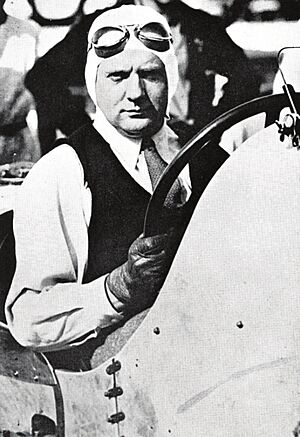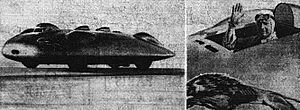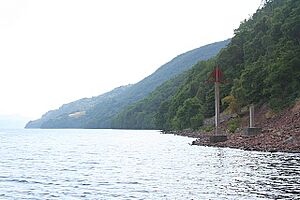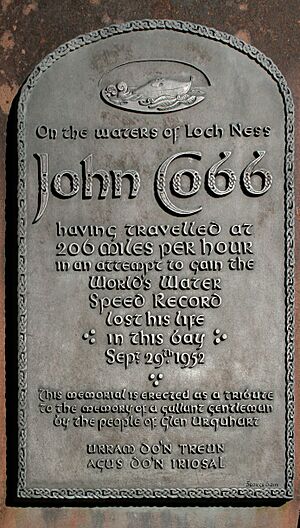John Cobb (racing driver) facts for kids
John Rhodes Cobb (born December 2, 1899 – died September 29, 1952) was a famous English race car driver. He held the World Land Speed Record three times. He set these records in 1938, 1939, and 1947 at the Bonneville Speedway in Utah, USA. In 1947, he also received the Segrave Trophy for his achievements. Sadly, John Cobb died in 1952 while trying to break the World Water Speed Record. He was driving a jet-powered speedboat on Loch Ness in Scotland.
Contents
Early Life and Beginnings
John Cobb was born in Esher, Surrey, England, on December 2, 1899. His home was very close to the Brooklands motor racing track, which he visited often as a boy. His father, Rhodes Cobb, was a rich fur broker in London.
John went to school at Eton College and later at Trinity Hall, Cambridge. After finishing school, he joined his father's business. He became a successful managing director of several companies. He used his own money to follow his passion for high-speed racing. In 1924, he even earned a pilot's license from the Royal Aero Club.
Racing and Speed Records
John Cobb won his first track race in 1925, driving a 1911 Fiat car. In 1926, he raced the Higham Special at the Brooklands track.
In 1928, he bought a powerful 10.5-liter Delage car from Paris. He raced this car at Brooklands from 1929 to 1933. During this time, he broke the track's outer lap record three times. On July 2, 1932, he reached an amazing speed of 138.88 miles per hour. He also won the British Empire Trophy at Brooklands in 1932.
In 1933, Cobb asked "Thomson & Taylor" to design and build a special car for him. This car was called the 24-liter "Napier Railton". With this car, he broke many track speed records. He set the ultimate lap record at the Brooklands track, which was never beaten. On October 7, 1935, he drove at an average speed of 143.44 miles per hour (230.84 km/h). He had already broken the record set by Sir Henry "Tim" Birkin in 1931 and then took it back from his friend Oliver Bertram.
John Cobb drove the Railton Special, a car powered by a regular engine with wheels. He broke the World Land Speed Record at the Bonneville salt flats on September 15, 1938. He reached a speed of 350 miles per hour. He broke his own record again at the same place on August 23, 1939, reaching 369 miles per hour.
War Service
During World War II, John Cobb served as an officer in the Royal Air Force. From 1943 to 1945, he worked with the Air Transport Auxiliary. This group helped move aircraft around during the war. He left the service with the rank of Squadron Leader. He even appeared in a wartime movie called Target for Tonight (1941).
Post-War Speed Records and Death
After the war, Cobb returned to the Bonneville salt flats in 1947. On September 16, he broke his own 1939 World Land Speed Record. He reached 394.19 miles per hour (634.39 km/h). On one of his two runs, he was even clocked at 403 miles per hour (649 km/h)! This amazing speed earned him the nickname "The Fastest Man Alive" from the newspapers. His record stood until 1963, when Craig Breedlove from America finally broke it.
After his land speed success, Cobb wanted to become the fastest man on water too. He ordered a jet-engine powered speedboat called Crusader from Vospers. He chose Loch Ness in Scotland for his speed trial because it was a long body of water.
On September 29, 1952, John Cobb was killed at the age of 52. He was trying to break the world Water Speed Record on Loch Ness. He was driving Crusader at a speed over 200 miles per hour (320 km/h) when the boat lost control and broke apart. After studying videos of the crash, the boat's designer, Reid Railton, believed the crash happened because the boat became unstable. Cobb's body was found in the loch and buried in Esher, Surrey. The people of Glenurquhart later put up a memorial on the shore of Loch Ness to remember him.
In 2002, the remains of the speedboat Crusader were found on the bottom of Loch Ness, about 200 meters (660 ft) deep. In 2005, the site was made a protected area. A research team from National Geographic filmed the wreck in 2019.
Personal Life and Tributes
John Cobb married Elizabeth Mitchell-Smith in 1947. She passed away 14 months later. In 1950, he married Vera Victoria Henderson.
A public green area in Esher was named 'Cobb Green' to honor his achievements. In 2017, a Blue plaque was put up at Cranmere Primary School in Esher. This plaque remembers John Cobb and his amazing life.
Awards
- British Empire Trophy (1932)
- Segrave Trophy (1947)
- Queen's Commendation for Brave Conduct (1953)





